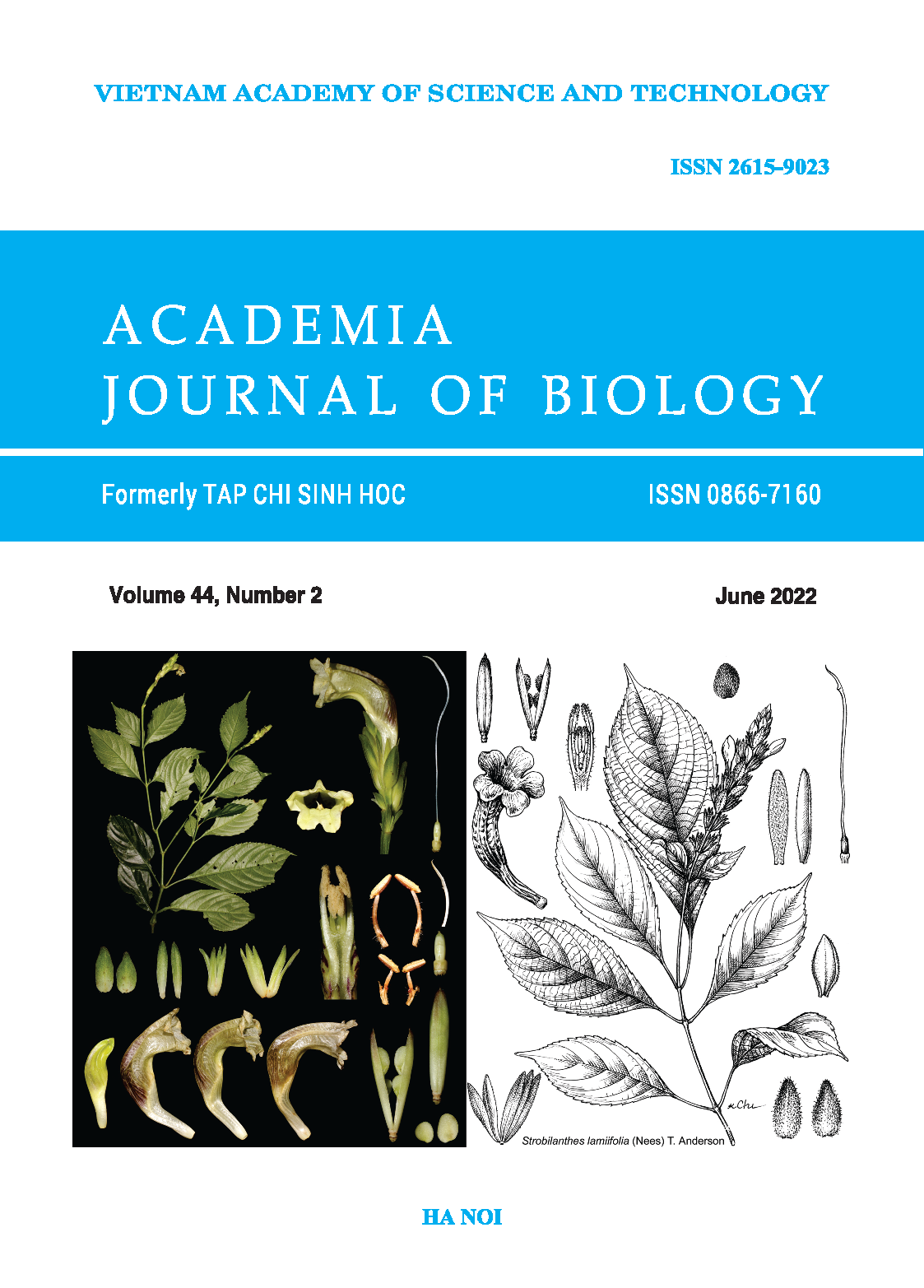Detection of c.G2194A mutation in \(\textit{AR}\) gene of a vietnamese patient with androgen insensitivity syndrome: a case report
Authors
DOI: https://doi.org/10.15625/2615-9023/16550Keywords:
Androgen insensitivity syndrome, AR gen, disorders of gender development.References
Batista R. L., Costa E. M. F., Rodrigues A. de S., Gomes N. L., Faria J. A., Nishi M. Y., Arnhold I. J. P., Domenice S., Mendonca B. B de, 2018. Androgen insensitivity syndrome: a review. Arch. Endocrinol. Metab., 62: 227–235. https://doi.org/10.20945/2359-3997000000031
Davison S. L., Bell R., 2006. Androgen physiology. Semin. Reprod. Med., 24: 71–77. https://doi.org/10.1055/s-2006-939565
Eisermann K., Wang D., Jing Y., Pascal L. E., Wang Z., 2013. Androgen receptor gene mutation, rearrangement, polymorphism. Transl. Androl. Urol., 2: 137. https://doi.org/10.3978/j.issn.2223-4683.2 013.09.15
Hannema S. E., Scott I. S., Hodapp J., Martin H., Coleman N., Schwabe J. W., Hughes I. A., 2004. Residual activity of mutant androgen receptors explains wolffian duct development in the complete androgen insensitivity syndrome. J. Clin. Endocrinol. Metab., 89: 5815–5822. https://doi.org/10.1210/jc.2004-0709
Li H., Durbin R., 2009. Fast and accurate short read alignment with Burrows-Wheeler transform. Bioinforma. Oxf. Engl., 25: 1754–1760. https://doi.org/ 10.1093/bioinformatics/btp324
McKenna A., Hanna M., Banks E., Sivachenko A., Cibulskis K., Kernytsky A., Garimella K., Altshuler D., Gabriel S., Daly M., DePristo M. A., 2010. The Genome Analysis Toolkit: A MapReduce framework for analyzing next-generation DNA sequencing data. Genome Res.,
: 1297–1303. https://doi.org/10.1101/gr.107524.11
Modi P. K., Faiena I., Kim I. Y., 2016. Chapter 3 - Androgen Receptor, in: Mydlo J. H., Godec C. J. (Eds.), Prostate Cancer (Second Edition). Academic Press, San Diego, pp. 21–28. https://doi.org/ 10.1016/B978-0-12-800077-9.00003-7
Nadal M., Prekovic S., Gallastegui N., Helsen C., Abella M., Zielinska K., Gay M., Vilaseca M., Taulès M., Houtsmuller A. B., van Royen M. E., Claessens F., Fuentes-Prior P., Estébanez-Perpiñá E., 2017. Structure of the homodimeric androgen receptor ligand-binding domain. Nat. Commun., 8: 14388. https://doi.org/ 10.1038/ncomms14388
Nguyen H. H., Khanh Nguyen N., Dung Vu C., Thu Huong Nguyen T., Nguyen N.-L., 2020. Late-Onset Ornithine Transcarbamylase Deficiency and Variable Phenotypes in Vietnamese Females With OTC Mutations. Front. Pediatr., 8: 321. https://doi.org/10.3389/fped.2020.00321
Nguyen T. H., Nguyen N. L., Vu C. D., Ngoc C. T. B., Nguyen N. K., Nguyen H. H., 2021. Identification of three novel mutations in PCNT in vietnamese patients with microcephalic osteodysplastic primordial dwarfism type II. Genes Genomics, 43: 115–121. https://doi.org/ 10.1007/s13258-020-01032-5
Pang J. P., Shen C., Zhou W. F., Wang Y. X., Shan L. H., Chai X., Shao Y., Hu X. P., Zhu F., Zhu D. Y., Xiao L., Xu L., Xu X. H., Li D., Hou T. J., 2021. Discovery of novel antagonists targeting the DNA binding domain of androgen receptor by integrated docking-based virtual screening and bioassays. Acta Pharmacol. Sin.,.
https://doi.org/10.1038/s41401-021-00632-5
Rosa S., Biason-Lauber A., Mongan N. P., Navratil F., Schoenle E. J., 2002. Complete Androgen Insensitivity Syndrome Caused by a Novel Mutation in the Ligand-Binding Domain of the Androgen Receptor: Functional Characterization. J. Clin. Endocrinol. Metab., 87: 4378–4382. https://doi.org/ 10.1210/jc.2002-020139
Tan M. E., Li J., Xu H. E., Melcher K., Yong E., 2015. Androgen receptor: structure, role in prostate cancer and drug discovery. Acta Pharmacol. Sin., 36: 3–23. https://doi.org/10.1038/aps.2014.18
Vija L., Ferlicot S., Paun D., Bry-Gauillard H., Berdan G., Abd-Alsamad I., Lombès M., Young J., 2014. Testicular histological and immunohistochemical aspects in a post-pubertal patient with 5 alpha-reductase type 2 deficiency: case report and review of the literature in a perspective of evaluation of potential fertility of these patients. BMC Endocr. Disord., 14: 43. https://doi.org/10.1186/1472-6823-14-43
Wang Z., Zhou Y., Yang R., Xia M., Zeng H., Du L., Ren J., Guo Q., 2017. Whole Exome Sequencing Identifies a c.C2566T Mutation in the Androgen Receptor in a Chinese Family. Clin. Labi, 63. https://doi.org/ 10.7754/Clin.Lab.2017.170316
Wu X., Zhou Q., Mao J., Lu S., Nie M., 2010. Mutational analysis of androgen receptor gene in four Chinese patients with male pseudohermaphroditism. Fertil. Steril., 93: 2076.e1–4. https://doi.org/10.1016/ j.fertnstert.2009.11.025
Yuan S. M., Zhang Y. N., Du J., Li W., Tu C. F., Meng L. L., Lin G., Lu G. X., Tan Y. Q., 2018. Phenotypic and molecular characteristics of androgen insensitivity syndrome patients. Asian J. Androl., 20: 473–478. https://doi.org/10.4103/ aja.aja_17_18
Downloads
Metrics
Downloads
PDF Downloaded: 88





